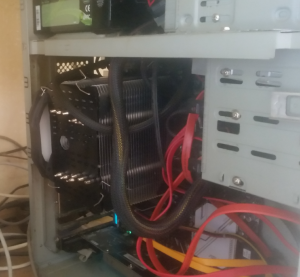After Lausitzring
I ordered a new motherboard, an AMD Ryzen 6-Core CUP with 16 GB DDR-4 RAM and a Macho Rev. 2b Cooler on Thursday, May 18th 2017. Paid by cash in advance, because mindfactory didn’t offer payment by credit card. Anyway, a colleague of mine ordered a gaming computer there before, so prepayment was no problem. The shipment arrived on Saturday, the 20th, when I was at the Lausitzring. Because we left early, I got the package from my neighbor Sunday evening.
Unpacking
Craptastic. The biggest box in the parcel was the Macho CPU-Cooler! It’s so big that I can’t even close the lid on my casing. Was quite a challenge to assemble. It looks like this:
The heat sink is the big thing in the middle, the turning fan is the white thing to the leftmost. My bedside cabinet was easier to put together!
With the ASUS-AM4-Board you don’t have to remove the backplate. Actually, you can’t. The spacers fit into the threads if you remove the brackets (barely). The heat sink still slides when you fasten the screws, but fortunately it doesn’t really matter.
I benchmarked the whole thing by re-encoding several videos from 1080p to 720p with ffmpeg, threaded. The temp didn’t raise over 65 °C, and it’s blazing fast. My old 6 core did it in real time, now it’s about half the time. At least ffmpeg says so…
Loudness
At first I thought it would be a problem that I couldn’t close the lid, but it isn’t. Actually, the external RAID with 4 hard discs is louder than the CPU fan on full speed. Good thing I orderd the separate cooler. I thought they’d deliver the CPU boxed, with one, but as it turns out, they didn’t.
First Boot
Well, after stuffing everything into the small casing, I pushed the power button and… Nothing! Fortunately I quickly remembered that I forgot to connect the whole Shebang, HDD-Led, power button, speaker and such to the panel. So, disconnect everything (VGA, USB, Network), get it out from under the table and fix it. Next try: One short beep, three long ones, no picture on either display. Shit!
The manual says that it means a missing graphics card. There definitely is one, but maybe in the wrong slot. I now have 3 PCI-Express slots. The first one isn’t usable, because it’s covered by the giant heat sink. So I get under the table and place the NVIDIA-Card into the downmost slot.
That did it! I’m greeted by an UEFI-BIOS and press DEL instantly. Not much to do in there, besides turning on SVM (Virtualization). I managed to get all 3 network cables right the first time, so I have network! The external SATA-casing is no problem, either, instantly recognized. Perfect!
htop shows 12 CPUs, 6 real cores, and 6 Hyperthreading. No fiddling around with UEFI-shit. Grub loads the kernel, as it shoud. Share and enjoy!
